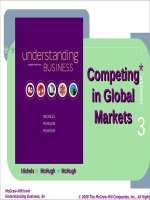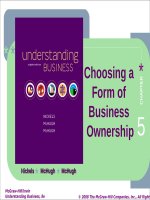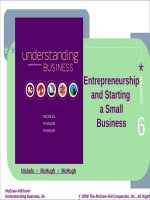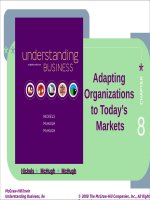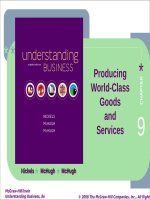Understanding business 11th by mchugh nickels chap001
Bạn đang xem bản rút gọn của tài liệu. Xem và tải ngay bản đầy đủ của tài liệu tại đây (5.15 MB, 54 trang )
CHAPTER 1
Taking Risks and
Making Profits
within the
Dynamic Business
Environment
McGraw-Hill/Irwin
Copyright © 2015 by the McGraw-Hill Companies, Inc. All rights reserved.
LEARNING OBJECTIVES
1. Describe the relationship between profit and
risk, and show how businesses and nonprofits
can raise the standard of living for all.
2. Compare and contrast being an entrepreneur
and working for others.
3. Analyze the effects of the economic
environment and taxes on businesses.
4. Describe the effects of technology on
businesses.
1-2
LEARNING OBJECTIVES
5. Demonstrate how businesses can meet and
beat competition.
6. Analyze the social changes affecting
businesses.
7. Identify what businesses must do to meet global
challenges, including war and terrorism.
8. Review how past trends are being repeated in
the present and what those trends mean for
tomorrow’s college graduates.
1-3
SAMMY HAGAR
Entrepreneur
• Has juggled a long music
career with lucrative
businesses.
• Started investing while in his
first band.
• Opened the Cabo Wabo
Cantina in 1990 and has since
increased the brand.
• Donates large amounts to help
feed the hungry.
1-4
NAME that COMPANY
Just before Christmas 2013, hackers stole more
than 110 million credit card numbers from this
retailer’s computer system requiring all customers to
monitor activity on these accounts and or get new
credit cards. The company’s profits fell nearly 50%
for the quarter.
Name that company!
1-5
GOODS and SERVICES
LO 11
• Goods Tangible products such as computers,
food, clothing, cars and appliances.
• Services Intangible products (that can’t be held in
your hand) like education, healthcare, insurance,
recreation and travel.
• Successfully filling a market need means you
could make money for yourself and provide jobs
for others.
1-6
BUSINESS and
ENTREPRENEURSHIP
LO 11
• Business Any activity that seeks to provide
goods and services to others while operating at a
profit.
• Entrepreneur A person who risks time and
money to start and manage a business.
• Success in business is often based on the
strategy of finding a need and filling it.
1-7
REVENUE, PROFIT AND LOSS
LO 11
• Revenue The total amount of
money a business takes in during
a given period by selling goods
and services.
• Profit The amount of money a
business earns above and
beyond what it spends for salaries
and other expenses.
• Loss Occurs when a
business’s expenses are more
than its revenues.
1-8
RISK
LO 11
• Risk The chance an
entrepreneur takes of losing
time and money on a
business that may not prove
profitable.
• Not all businesses make
the same amount of profit.
• Businesses take risks, but
with great risks could
come great profit.
1-9
HOW is TAX MONEY USED?
LO 11
Taxes are used to provide:
•Hospitals
•Schools
•Libraries
•Playgrounds
•Roads
•Fire Protection
•Police Protection
•Environmental Programs
•Support for People in Need
1-10
STANDARD of LIVING
LO 11
• Standard of Living The
amount of goods and services
people can buy with the money
they have.
• The U.S. has one of the highest
standards of living in the world.
• Workers in other countries may
make more money, but prices for
products are higher.
Photo Credit: Walmart Stores
1-11
QUALITY of LIFE
LO 11
• Quality of Life The general wellbeing of a society
in terms of its political freedom, natural environment,
education, healthcare, safety, amount of leisure and
rewards that add to personal satisfaction.
1-12
STAKEHOLDERS
LO 11
• Stakeholders All the people who stand to gain or
lose by the policies and activities of a business and
whose concerns the businesses need to address.
• Who are Stakeholders?
- Customers
- Employees
- Stockholders
- Suppliers
- Dealers
- Community Members
- Media
- Elected Officials
- Bankers
- Environmentalists
1-13
STAKEHOLDERS
LO 11
1-14
OUTSOURCING
and INSOURCING
LO 11
• Outsourcing Contracting with other companies
(often in other countries) to do some of the firm’s
functions, like production or accounting.
• Insourcing Foreign companies opening offices
and factories in the United States.
1-15
NONPROFIT ORGANIZATIONS
LO 11
• Nonprofit Organization An organization whose
goals do not include making a personal profit for its
owners or organizers.
1-16
WELLKNOWN NONPROFITS
in the UNITED STATES
LO 11
United Way
American Heart Association
Salvation Army
American Cancer Society
American Red Cross
1-17
KEEPING STRONG EMPLOYEES
at NONPROFITS
LO 11
1. Set ambitious, but realistic
goals.
2. Allow all employees to
work with the groups they
are serving.
3. Give employees a break.
Nonprofit work is draining.
Source: Fast Company, accessed October 2014.
1-18
TEST PREP
• What is the difference between revenue and
profit?
• What is the difference between standard of living
and quality of life?
• What is risk? How is it related to profit?
• What do the terms stakeholders, outsourcing and
insourcing mean?
1-19
THE UPS and DOWNS
of ENTREPRENEURSHIP
LO 12
The UPS
The DOWNS
The freedom to succeed.
The freedom to fail.
Make your own decisions.
No paid vacations.
High possibility of wealth.
No health insurance.
Hire your own staff.
No daycare.
1-20
HOW a FOOD TRUCK HELPED REBUILD
a STORMSTRUCK COMMUNITY
• After witnessing the destruction left behind after
Hurricane Sandy, Mike Diamond started
Rockaway Plate to serve free lunches.
• Now the truck is a profitable business that helps
local teens gain work experience.
1-21
WHO TAKES the
ENTREPRENEURIAL CHALLENGE?
LO 12
• Millions of people have
started businesses and
succeeded.
• The number of Hispanic
owned businesses in the
U.S. has grown
dramatically.
• Women now own over
onethird of all businesses.
1-22
WOMEN in the WORKFORCE
Source: Bloomberg Businessweek, accessed October 2014.
LO 12
1-23
FIVE FACTORS of PRODUCTION
LO 12
• Entrepreneurs use what they’ve learned to grow
their businesses and increase wealth.
1-24
TEST PREP
• What are some of the advantages of working for
others?
• What benefits do you lose as an entrepreneur,
and what do you gain?
• What are the five factors of production? Which
ones seem to be the most important for creating
wealth?
1-25


